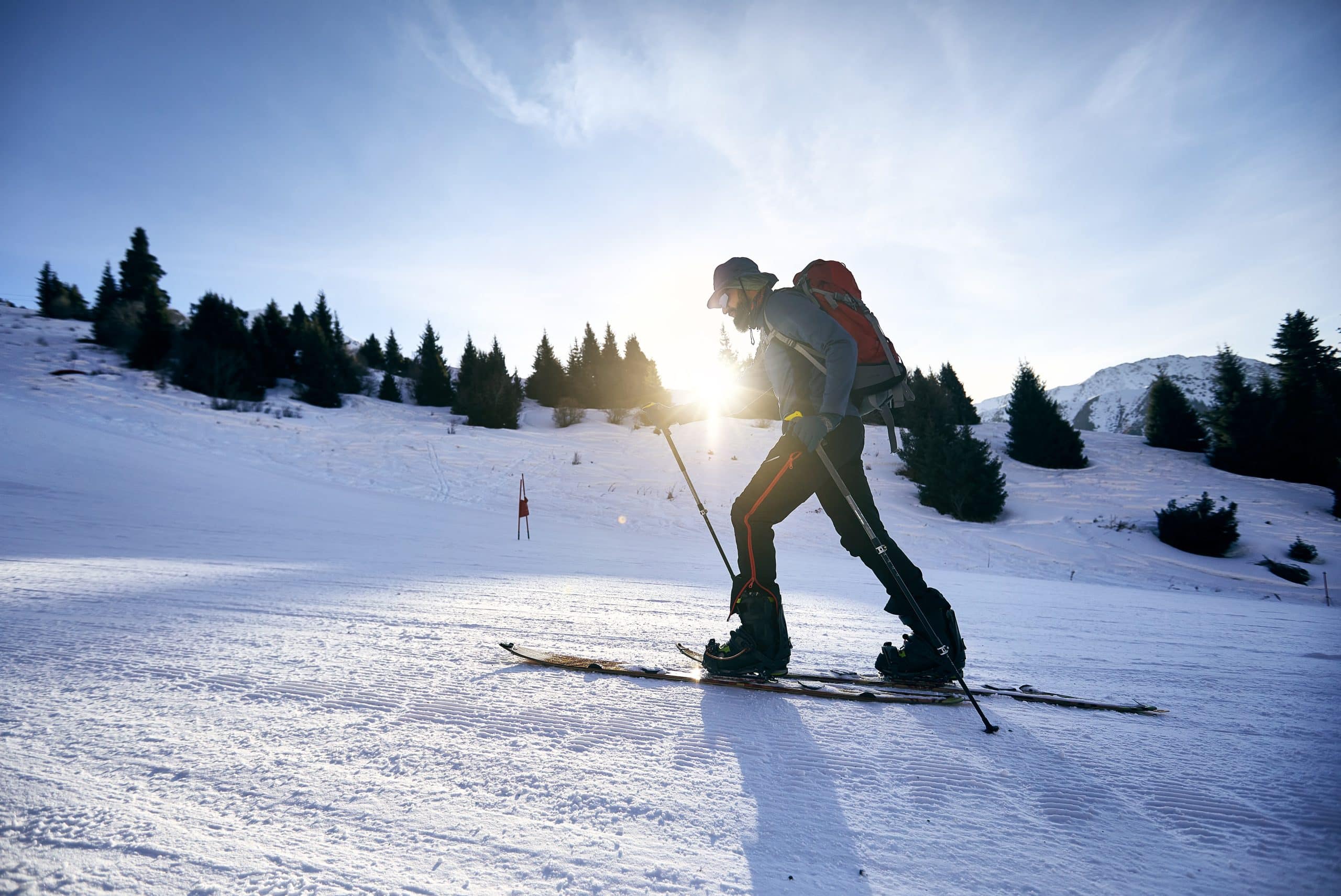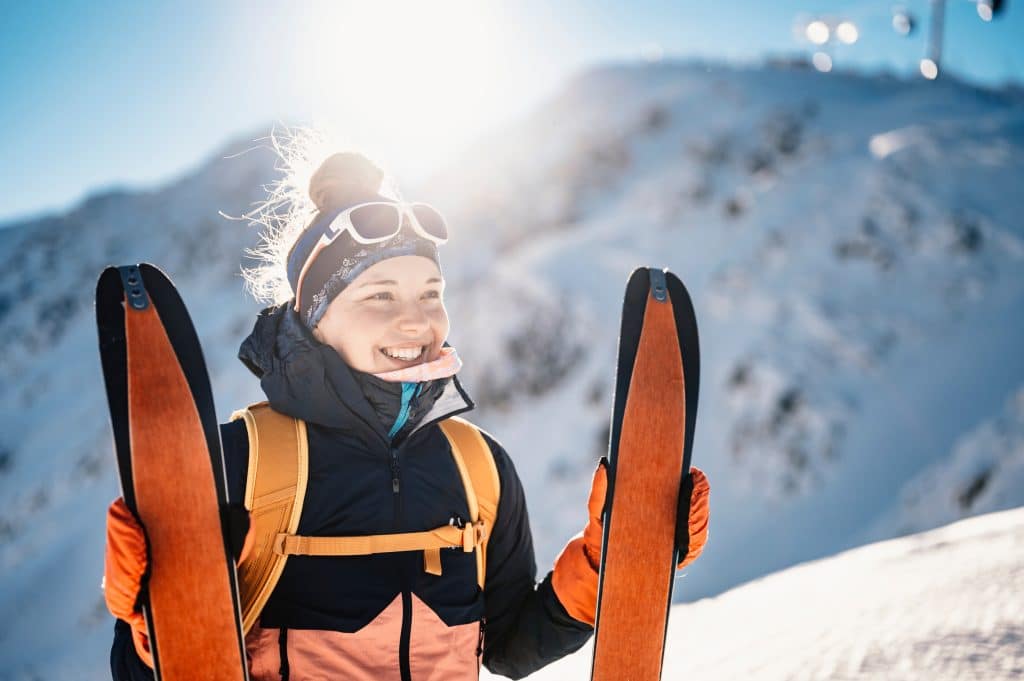Picture this: the crisp mountain air brushing against your cheeks, the sun glistening on the snow, and the sheer joy of defying gravity as you zoom down the slopes. But here’s the twist – while you’re relishing every twist and turn, your body is engaged in a high-energy battle against the cold, torching calories like a snow-melting inferno.
Winter is a harsh season for most people and is characterized by a gloomy atmosphere but not for adventure lovers. In winter, many adventurous people impatiently wait for winter sports to commence. Amongst these, skiing and snowboarding are the most popular winter sports in many parts of the world (18). Not only is skiing just a recreational sport, but the calories burned in skiing are quite a lot!
Skiing is gliding on snow with long skis and narrow flat boards (17). It is also used as a mode of transport in various regions and is not just a recreational or competitive sport. It is a great workout and burns calories regardless of the reason for skiing.
Skiing, my friend, is not just a winter sport. It is a winter romance with fitness.
So, skiing offers more than an adrenaline rush, whether you’re chasing the thrill, aiming to conquer the black diamonds, or simply savoring the charm of the bunny hill. This calorie-burning affair turns frozen landscapes into your gym. Are you willing to strap your ski boots and dive into the science behind the snowfall? Join us as we explore how many calories you can shed while sliding in winter’s playground.
How Many Calories Do You Burn in a Day of Skiing?
Skiing is an adventurous sport, but at the same time, it is extremely tiring as the average calories burned skiing are generally 300 – 600 calories per hour (12). The calories burned in skiing depend on various factors such as the type of skiing, intensity, the skier’s health, skill, weight and age, and the terrain and time duration.
For a full day of skiing, which typically involves around 4-6 hours on the slopes, you could burn anywhere from 1200 to 3600 calories or even more, depending on the above factors (12). Remember that skiing is not only about the downhill runs; walking to and from lifts, maintaining balance, and navigating through snow contribute to the overall calorie expenditure.
BetterMe app will kick you out of the mental funk, shake off your extra weight, rid you off your energy-zapping habits, and help you sculpt the body of your dreams. Intrigued? Hurry up and change your life for the better!
What Kind of Skiing Burns the Most Calories?
If you are wondering about initiating your journey into the world of skiing, you should understand the different types of skiing out there. Calories burned at skiing beginner level may differ from those burned at a pro level.
As mentioned, skiing has multiple styles, with the most common ones being Alpine or Downhill skiing, Cross-Country or Nordic skiing, Back-Country skiing, Freestyle skiing, Telemark skiing, Adaptive skiing, and Off-piste skiing (2).
Let’s look at each type of skiing and calories burned to find out which burns the most calories!
Downhill/Alpine Skiing
As the name suggests, Downhill skiing is skiing down the hill (2). And you know what? Almost all age groups can do it!
To enjoy the thrill of skiing down a hill in this manner requires no extra training, so anyone can do it. Skiers typically use bindings that fix their heels to the skis and can use various techniques to control their speed and direction.
As per the Mayo Clinic, if someone weighs around 155 pounds, they can burn about 430 calories by skiing downhill at a medium speed for half an hour. If they keep skiing for a full hour, they might burn roughly 860 calories (11). The downhill skiing calories burned for beginners can be more.
Cross-Country/Nordic Skiing
Cross-country skiing involves skiing on relatively flat terrain. This could be through forests or open fields. Skiers use skis with bindings that allow their heels to lift, enabling a gliding motion. This type of skiing is often used for fitness and endurance training (2).
It can be done on groomed trails, often more accessible than steep downhill ski slopes. There is no need to look for lifts or specific slopes to enjoy this type of skiing. According to the famous Olympian Jessie Diggins, cross-country skiing of 1 hour can burn calories equivalent to that of a Chipotle burrito (15).
Back-Country Skiing
Backcountry skiing occurs in unmarked and often remote areas, away from groomed slopes. Skiers hike or use specialized equipment like climbing skins to ascend before skiing down, continually seeking untouched powder snow.
This type of skiing is when you ski in places that aren’t marked or prepared, like regular ski slopes. You may not know exactly what the land will be like and must be ready for anything.
Nobody can say what the land will be like in backcountry skiing. This is why it’s considered risky, even if you’re good at skiing.
Freestyle Skiing
Freestyle skiing is a type of skiing where people do tricks while jumping in the air. They try to flip, go high, and make cool moves before they land back on the ground. It includes various jumps and acrobatics performed on skis. Athletes can also hone and flaunt their skills while doing moguls, aerials, halfpipe, and slopestyle.
You can do this in special areas called freestyle parks or in the mountains. If you’re wondering where to do freestyle skiing, ski resorts are great places. The downhill part of the resort is perfect because it has a smooth path and ramps for doing tricks.
Telemark Skiing
Telemark skiing is a style that combines elements of alpine and cross-country skiing. The skier’s heel stays free, allowing for a lunging motion signifying a traditional Scandinavian skiing technique.
Telemarking is a different way to ski that can be a fun challenge. Trying it might help you get better at regular skiing. It’s especially cool to try on indoor snow slopes where there is a limited amount of space. It’s fun and good exercise, and when you do your first Telemark turns, it feels great, and you have achieved a milestone!
Adaptive Skiing
Adaptive skiing is a form that allows individuals with disabilities to participate in the sport. It uses special equipment, and support from certified instructors to fulfill the needs of individuals with physical, sensory, or cognitive impairments.
This type of skiing aims to provide an enjoyable experience for everyone, regardless of their disability. Besides this, there is a strong connection between adaptive skiing and calories burned. While cutting that fat, this sport allows individuals with disabilities to experience a thrill on snow-covered slopes.
If someone is interested in adaptive skiing, reaching out to adaptive programs at ski resorts can be a great starting point to learn and participate.
Off-piste Skiing
Off-piste skiing, also known as backcountry skiing or off-trail skiing, refers to skiing on ungroomed, natural terrain. Unlike skiing on prepared slopes within a ski resort, off-piste skiing occurs in unmarked and often remote areas.
Skiers can experience untouched powder snow, varied terrain, and a greater sense of adventure. It’s a popular activity for those seeking a more challenging and less crowded skiing experience.
During off-piste skiing, calories burned can be difficult to estimate due to the diverse factors at play, such as snow depth, skiing technique, and individual fitness levels, it’s safe to say that off-piste skiing can significantly ramp up your calorie expenditure.
Read more: Fall Health Tips To Make Your Autumn And Winter Months Easier And More Fun.
When Are the Most Calories Burned in Skiing?
Cross-country skiing tends to burn the most calories compared to other forms of skiing. This is primarily because cross-country skiing engages the upper and lower body in a continuous, rhythmic motion. It provides an excellent cardiovascular workout and engages many muscle groups (8).
Pushing with the poles and gliding with the skis requires significant effort and energy. The hilly terrain and varying speeds may also increase calorie burn. Plus, the longer duration of cross-country skiing sessions compared to other forms of skiing can lead to higher overall calorie expenditure.
On average, cross-country skiing can burn around 400 to 800 calories per hour or even more, depending on the skier’s weight, speed, technique, and incline level (6). It’s important to note that the exact calorie burn can differ from person to person based on individual factors.
Even though cross-country skiing has the potential to burn more calories, you should choose a skiing style according to your current skill level and preferences. Note that all forms of skiing offer unique benefits and contribute to overall health and muscular strength.
Knowing about the factors that affect your calorie loss during skiing can help you to opt for a relevant style. Here are some factors that you should know about:
Factors that Affect Calories Burned When Skiing
Here are some key factors that affect calories burned when skiing:
Type of Skiing
Different types of skiing (e.g., downhill, cross-country, freestyle) require varying levels of effort and engage other muscle groups. Cross-country skiing, for example, tends to burn more calories due to its continuous and demanding motion.
Intensity
The level of effort you put into skiing significantly affects calorie burn. Skiing at a higher intensity, whether going faster, skiing on more challenging terrain, or using vigorous techniques, can burn more calories (19).
Terrain
Skiing on steeper or more challenging terrain requires more energy, as you have to work harder to maintain balance, control speed, and navigate obstacles (16).
Body Weight
Heavier individuals tend to burn more calories during physical activities, including skiing, as their bodies demand more energy to move (1).
Altitude
Skiing at higher altitudes requires greater cardiovascular effort due to the lower oxygen levels. This may result in a slight increase in calorie burn (10).
Age and Gender
Younger individuals and males tend to have a slightly higher metabolic rate, which can impact their calorie burn (1).
To sum up, the exact calorie burn will vary from person to person based on these factors. Using fitness trackers or heart rate monitors can provide accurate estimations, helping you to curate a meaningful skiing session.
Is Skiing a Good Way to Lose Weight?
Yes, skiing can be an effective way to aid in weight loss when combined with a balanced diet and overall healthy lifestyle. It is one of the winter exercise ideas most fitness experts are rooting for.
Skiing is a physically demanding activity that engages multiple muscle groups and can burn many calories. The calories burned from skiing can create a calorie deficit necessary for weight loss. It is a full-body workout involving aerobic and anaerobic activity (16).
When you ski downhill, traverse across slopes, and use your muscles to control your movements, you may eventually experience a substantial calorie burn. The more intense and challenging the terrain, the more calories you’re likely to burn (16). Skiing engages muscles in your legs, core, and upper body. This can contribute to muscle toning and increased metabolic rate. Building muscle mass can further enhance your body’s ability to burn calories.
BetterMe app is a foolproof way to go from zero to a weight loss hero in a safe and sustainable way! What are you waiting for? Start transforming your body now!
Unlike traditional gym workouts, skiing offers variety and enjoyment. This can motivate you and heighten your eagerness to improve at the sport. Weight loss primarily occurs when you burn more calories than you consume. While skiing can help create a calorie deficit, combining it with a balanced diet is essential for sustainable weight loss.
Further, you can include workouts like running in place exercise and running to gain maximum benefits. Look up the benefits of running in the morning to inspire yourself for those dreaded morning runs. You may fall in love with the routine!
Incorporating skiing into your fitness regime can be a fun and effective way to promote weight loss and enhance your health. Some perks that you gain from skiing are:
Cardiovascular Fitness
Skiing is an excellent cardiovascular workout that increases your heart rate and strengthens your heart and lungs. The constant motion and elevation changes challenge your cardiovascular system, which can lead to its improved efficiency (8).
Muscular Strength
Skiing engages multiple muscle groups, including the legs, core, back, and upper body. Pushing off with your poles during cross-country skiing and maintaining balance while navigating downhill slopes require muscular strength and endurance. You may notice a gradual improvement in your power as you glide on your ski boards throughout the season.
Flexibility, Balance, and Coordination
Skiing requires high balance and coordination, especially when navigating challenging terrain or performing tricks. It involves a range of motion in various joints, promoting flexibility in the hips, knees, ankles, and spine (5).
Improved Mental Health
Skiing takes you outdoors and exposes you to natural beauty and fresh air. This can bring positive effects on your psychological health. Being surrounded by nature while engaging in physical activity can reduce stress, anxiety, and depression (3).
Does Skiing Burn Belly Fat?
So far, we know that skiing can contribute to overall fat loss. This can lead to a reduction in belly fat. However, it’s important to understand that spot reduction (targeting fat loss from a specific area, such as the belly) is not a highly effective or reliable strategy. Fat loss occurs across the body rather than in specific areas (14).
We should acknowledge that fat loss is a gradual process. Focusing solely on belly fat can lead to frustration, as fat loss can be influenced by genetics, hormonal balance, physical activity levels, diet, sleep, and individual body composition (4).
Remember that a holistic approach can be more fruitful if you’re concerned about belly fat. This should cover cardiovascular exercise, strength training, healthy eating, and lifestyle changes. Always consult a healthcare professional before significantly changing your exercise or diet regimen, especially if you are on medications or have some health conditions.
How to Get Ski Fit in 3 Weeks?
Getting ski fit requires minimally 8-12 weeks, but if you are physically fit and have a proper workout regimen, you can train in 3 weeks or less (13).
Getting ski fit in just three weeks requires a focused and intense approach to your fitness routine. You can make some progress quickly by following a structured plan. Check out this quick roundup of workouts you should do during the three weeks:
- First Week: focus on building cardiovascular strength and flexibility. Engaging in 30 minutes of intense cardio, like running, can be beneficial.
- Second Week: Focus more on functional and ski-specific training. This can include full-body strength training, lunges, and high-intensity interval training (HIIT) sessions.
- Third Week: Opt for endurance training, agility exercises, and advanced ski techniques.
By focusing on strength training, ski-specific exercises, and technique work, you can prepare your body to handle the physical demands of skiing.
Read more: Cold Weather Jogging – The Excellent Way To Get Invigorated During Winter.
The Bottom Line
Apart from offering thrill and pleasure, skiing has emerged as an incredible way to lose unwanted fat. The rush of downhill skiing, the endurance of cross-country exploration, and the uncharted challenges of off-piste skiing can uplift you physically and mentally.
This article has clarified how skiing can be your next fitness companion. It is a way to uncover your hidden strength amidst beautiful snowy peaks. It doesn’t matter if you are a beginner or a professional skier; this activity can bring you joy beyond bounds!
Frequently Asked Questions (FAQs)
Is skiing a full-body workout?
Yes, skiing is a full-body workout. It engages multiple muscle groups in the legs, core, and upper body, providing a comprehensive physical challenge. This can lead to improved strength, endurance, and cardiovascular fitness.
Will I lose weight skiing for a week?
A week of skiing can contribute to weight loss. Don’t forget to combine it with a balanced diet and active lifestyle. The amount of weight lost in a week will vary based on individual factors such as intensity of skiing, energy intake, weight, and metabolism.
How many calories are 5 hours of skiing?
On average, skiing can burn around 300-600 calories per hour. Therefore, 5 hours of skiing could burn about 1500-3000 calories. This may vary according to individual factors.
Does skiing tone legs?
Yes, skiing can help tone and strengthen the muscles in your legs due to constant navigation across slopes and movement control.
Is skiing good for your knees?
Skiing can be stressful on the knees, particularly during downhill descents. Proper technique, equipment, and knee-strengthening exercises can help reduce the risk of knee strain and injuries.
DISCLAIMER:
This article is intended for general informational purposes only and does not serve to address individual circumstances. It is not a substitute for professional advice or help and should not be relied on for making any kind of decision-making. Any action taken as a direct or indirect result of the information in this article is entirely at your own risk and is your sole responsibility.
BetterMe, its content staff, and its medical advisors accept no responsibility for inaccuracies, errors, misstatements, inconsistencies, or omissions and specifically disclaim any liability, loss or risk, personal, professional or otherwise, which may be incurred as a consequence, directly or indirectly, of the use and/or application of any content.
You should always seek the advice of your physician or other qualified health provider with any questions you may have regarding a medical condition or your specific situation. Never disregard professional medical advice or delay seeking it because of BetterMe content. If you suspect or think you may have a medical emergency, call your doctor.
SOURCES:
- 6 Factors That Can Affect How Many Calories You Burn (2022, everydayhealth.com)
- 8 Different Types Of Skiing – A Detailed Overview (2023, skiersguild.com)
- 8 Health Benefits of Getting Back to Nature and Spending Time Outside (2022, healthline.com)
- A Review of Weight Control Strategies and Their Effects on the Regulation of Hormonal Balance (2011, ncbi.nlm.nih.gov)
- A new kinematic dataset of lower limbs action for balance testing (2023, ncbi.nlm.nih.gov)
- Calories Burned Skiing Calculator (n.d., caloriesburnedhq.com)
- Can I Burn Fat by Skiing? (2021, asomammoth.com)
- Cardiovascular Effects and Benefits of Exercise (2018, ncbi.nlm.nih.gov)
- Cross-Country vs. Downhill Skiing: Which Makes You More Fit? (2018, health.clevelandclinic.org)
- Do you burn more calories at high altitudes? (2004, outsideonline.com)
- How Many Calories Do You Burn In A Day Of Downhill Skiing? (n.d., thedonutwhole.com)
- How many calories does skiing burn? (2020, skibro.com)
- How to Train for Skiing (n.d., rei.com)
- Is It Possible to Target Fat Loss to Specific Body Parts? (2018, healthline.com)
- Olympian Jessie Diggins says 1 hour of cross-country skiing burns the calories in a Chipotle burrito — and science proves her right (2018, businessinsider.com)
- Ski Pro Tips For Skiing At Every Level (2022, aspensnowmass.com)
- skiing (2023, britannica.com)
- Winter Sports – Statistics & Facts (2023, statista.com)
- Why skiing is an excellent exercise for burning calories (n.d., sloperunner.com)










